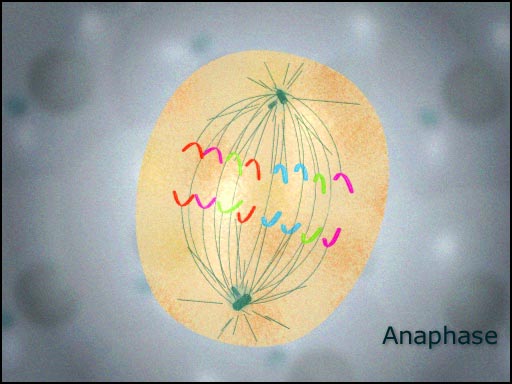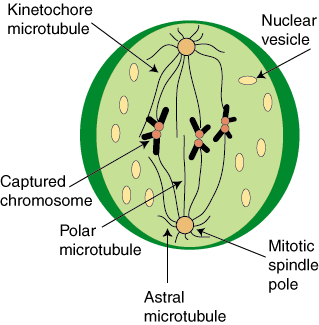The Mitosis Game will be an interactive lesson to teach children ages 9-14 about mitosis. Mitosis is the process by which living cells divide and reproduce. By interacting with a Computer Vision based Flash movie, children will be able to learn about this process in a more engaging way than with common teaching methods.

A diagram of mitosis taken from https://dbscience3.wikispaces.com/Drew. " The G1, S and G2 phases are part of Interphase.
Core Gameplay
The Mitosis Game will consist of a series of mini-games illustrating the various stages of mitosis. Each game will provide an interactive demonstration of the core function of that stage. The mini-game for each stage will be as follows:
Stage G1: In this stage, the cell grows in size to prepare for mitosis. Children will form holes in front of the projection to "hug" the cell. If the hole intersects the image of the cell on the screen, the cell will enlarge in size. The game will proceed to the next stage once the cell reaches a specific size.
Stage S: In this stage, the cell duplicates its DNA. After a brief animated explanation of the process, children will be shown a half-strand of DNA along with a series of loose nucleotides. The children will be asked to match these nucleotides to their correct partners: adenine to thymine, and guanine to cytosine. This will be accomplished by having the nucleotides react to and move along with hulls. When all the nucleotides have been matched, the game will proceed to the next stage.

A diagram of DNA, illustrating the two base pairings, from http://www.breakitdownblog.com/bush-signs-the-genetic-information-nondiscrimination-act/. Children will construct a similar structure in the Mitosis Game.

A diagram of DNA, illustrating the two base pairings, from http://www.breakitdownblog.com/bush-signs-the-genetic-information-nondiscrimination-act/. Children will construct a similar structure in the Mitosis Game.
Stage G2: This stage is virtually the same as G1. The cell grows further to ensure it is large enough to divide. Children will have to "hug" the cell again until it reaches its final size.
Prophase: During prophase, the centrosomes of the cell move to opposite sides of the cell. Children will have to move these centrosomes to their correct positions in a similar manner to that described for the nucleotides in the S stage. Once the centrosomes are in their correct positions, the game will proceed to the next stage.
A diagram of a cell in prophase taken from http://www.ias.unt.edu/~tpp001/Mitosis_Diagram_Page.main.html. Each pair of centrioles is collectively called a centrosome. Note that the two centrosomes are moving toward opposite ends of the cell.
Prometaphase: Two notable events occur in this stage. First, the nuclear envelope dissolves in preparation for the separation of chromosomes. The game will emulate this by having the child wave his or her hand over the image of the nucleus on the projection, causing the nuclear envelope to dissolve. Secondly, the centrosomes generate kinetochores, which reach toward the center of the cell. Children will be asked to move their hands toward the center of the cell to cause this to occur.

A diagram of a cell in prometaphase from Sparknotes' page on mitosis. Note that the nuclear envelope has dissolved into nuclear vesicles and that the kinetochores are extending toward the center of the cell.
Metaphase: In this stage, the chromosomes line up at the center of the cell. Children will have to align the chromosomes along the center line. Once the chromosomes are all in place, the game will move on.A diagram of a cell in metaphase, from http://www.uic.edu/classes/bios/bios100/lecturesf04am/lect16.htm. Notice the chrosomes aligned at the center.
Anaphase: In this stage, the kinetochores shorten and pull the chromosomes apart. The children will have to "stretch" the chromosomes toward the opposite ends of the cell. The game will accomplish this by keeping track of the distance between two hulls on the screen.
 A diagram of a cell in anaphase from iknow.net. Here the chromosomes are being pulled toward opposite ends of the cell.
A diagram of a cell in anaphase from iknow.net. Here the chromosomes are being pulled toward opposite ends of the cell.
Telophase: In this stage, the chromosomes reach their final positions at opposite ends of the cell and new nuclei are formed. Children will be asked to make holes at each end of the cell to "create" the new nuclei. Once each nucleus has been formed, the game will move to the next and final stage. A diagram of a cell in anaphase from iknow.net. Here the chromosomes are being pulled toward opposite ends of the cell.
A diagram of a cell in anaphase from iknow.net. Here the chromosomes are being pulled toward opposite ends of the cell.A diagram of a cell in telophase from http://www.biology.iupui.edu/biocourses/N100/2k2ch8mitosis.html. Notice that the new nuclei are beginning to form.
Cytokinesis: In this stage, the cell "pinches off" at the center and splits into two new cells. Children will be asked to form a "wall" between the two forming cells with their arms. The game will detect this as a hull and split the cell in response. Once the new cells are formed, the game ends.A diagram of cytokinesis from Stanford University, illustrating the division of the two new cells.





No comments:
Post a Comment